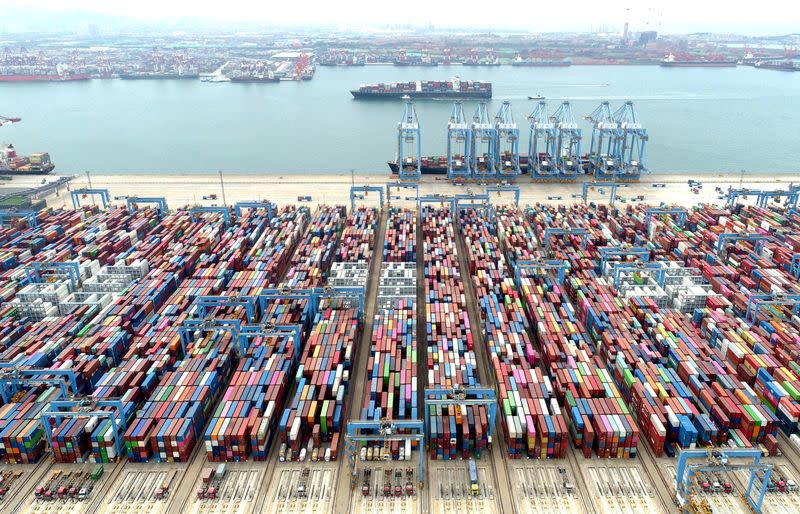A rush to boost chip supplies beefed up China’s imports in July, but exports grew by the slowest amount in three months, according to customs data released on Wednesday.
The slower export growth increases concern about the outlook for the country’s huge vast manufacturing sector.
Analysts say China’s factories will likely face stiff pressure in the months ahead, hobbled by Western tariffs and demand woes while volatility in financial markets and US recession fears raise fresh challenges for policymakers trying to bolster a fragile economic recovery.
ALSO SEE: A Third of Carbon Credits Fail on New ‘High-Integrity’ Criteria
Outbound shipments climbed 7.0% in July from the year earlier, the data showed, which was slower than June’s 8.6% rise and missed forecasts of a 9.7% increase.
“Due to base effect, China’s exports may keep a single-digit growth in the near future, but considering the slowing external demand and tariffs, the outbound shipments in the second half of 2024 will face bigger pressure,” Lynn Song, chief economist for Greater China at ING, said.
Imports rose at a robust 7.2% rate, reversing a 2.3% decline in June and marking the strongest performance in three months. It also beat analysts’ expectations of a 3.5% rise.
Chip purchases bid to beat new US curbs
The brighter imports figures were underpinned by Chinese firms’ rush to purchase chips ahead of expectations of further United States curbs on chips exports to the Asian giant, Xing Zhaopeng, senior China strategist at ANZ, said.
“Looking ahead, the upward trade cycle may have ended. Both imports and exports are expected to slow down in the third quarter.”
Imports of crude oil dropped in July to their lowest since September 2022, while those of iron ore and soybeans climbed from a year earlier.
Market reaction to the data was mixed. The Chinese yuan slipped against the dollar, but the nation’s stocks blue chip index advanced 0.2%.
The world’s second-largest economy has struggled to gain momentum despite government efforts to stimulate domestic demand following the pandemic. A protracted property slump and fears about job security have dragged heavily on consumer confidence.
Trade surplus drops
China’s economy grew 4.7% in the second quarter, below expectations, keeping alive calls for policymakers to roll out more support to hit the government’s full-year growth target of around 5%.
Chinese leaders pledged last week that the stimulus measures will be directed at consumers and the country will make “counter-cyclical adjustments” during the rest of 2024.
The government last month announced that about 150 billion yuan ($20.88 billion) of the 1 trillion yuan China is raising through special debt issuance this year will subsidise replacements of old appliances, cars and other consumer goods.
The measure deviated from the usual playbook of boosting investment to support the economy and fuelled expectations for more stimulus that targets household demand.
China’s trade surplus narrowed to $84.65 billion in July, compared with the $99 billion forecast and $99.05 billion recorded in June. The United States has repeatedly highlighted the surplus as evidence of trade advantages enjoyed by Chinese firms.
Concerns about global trade imbalance
The slowdown in export growth adds to concerns about the outlook for the sector, analysts say, with many countries growing increasingly uneasy about China’s trade dominance.
The US, Europe and emerging economies from Turkey to Indonesia have raised tariffs and placed other barriers on Chinese products. Washington announced in May plans to raise tariffs on an array of Chinese products on August 1 but decided it would delay some of them.
Chinese tech giants including Huawei and Baidu as well as startups have ramped up purchase of high bandwidth memory chips to stockpile in anticipation of US curbs on exports of semiconductors to China, Reuters reported on Tuesday.
Last month, for example, China’s imports from the US jumped 24.1% from a year earlier, in contrast to the 1.7% fall in June.
The sell-off in global markets this week sparked by fears of a possible recession in the US economy adds another layer of concern for Chinese exporters.
Zichun Huang, China economist at Capital Economics, said the slowing exports growth was mainly due to lower export prices as export volumes remained near record highs. That squeezed Chinese manufacturers’ profit margins.
A rattan outdoor furniture seller surnamed Jin said the sluggish economic growth pushed many factories which used to sell in China to shift to exports.
“We can feel the harsh competition clearly as many domestic competitors rushed into this industry this year,” Jin said, adding he had to cut prices by 10-20% for some products to stay competitive. “I feel external demand didn’t rebound this year.”
- Reuters with additional editing by Jim Pollard
NOTE: Another link was added to this report on August 7, 2024.
ALSO SEE:
New US Chip Equipment Export Rule to Hit Taiwan, ASEAN States
China to Use Bonds to Pay For Consumer Trade-in Scheme
China’s Growth Slows in 2nd Quarter, Downturn Hits Retail Sales
Climate Crisis Has Cost China Billions Already This Year
Conflicting Goals Could Limit Outcomes From China’s Plenum
China Shifting to ‘Green’ Steel Production as EU Levy Looms
China to Examine European Union’s Trade ‘Barriers’
























